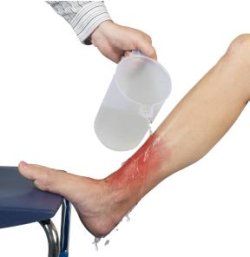With summer in full swing and numerous reports of fire related injuries rising, some first aid training is important to ensure that we know what to do in case of emergencies and also to protect ourselves and our loved ones.

Signs and Symptoms of Burns or Scalding
• Blisters
• Red skin (patients who suffered an electric shock might have blackened skin)
• Some swelling in the burned area might appear after some time
• Patient might feel dizzy or nauseous and might be cold, pale and sweaty
• Watery fluid might start seeping out of the injured area
Whether these symptoms will appear or not depend on the severity of the injury. It should also be pointed out that the amount of pain the patient feels isn’t always related to the seriousness of the injury.
First Aid for Burns
• The first thing that people taking first aid courses learn about burns is that the heat source should be immediately removed from the victim and vice versa.
• The injured area should be immediately cooled for up to 20 minutes. Most would run cool tap water over the affected area but in the absence of a sink or a shower stall, any cool but clean liquid like a beer or a soda can be used.
• A burn gel can also be used instead of water but make sure that there’s enough gel to totally cover the burnt area.
• Immediately and carefully remove clothing that has been splashed with a chemical or any hot liquid.
• Any jewelry, like bracelets, rings or watches, should be removed because there’s a chance that the burnt area would swell up.
• Call 911 or any emergency personnel if the patient is badly burnt or if the injury is causing tremendous pain. Speed and extra care should also be taken when the burn is more than half of the patient’s arm of if the eyes are involved.
• Lay the burn patient down if he or she is complaining of feeling faint.
• Depending on the location of the injury, place the affected area in a bowl or tub of cold water instead of splashing water on the burn.
• Apply a clean dressing 20 minutes after the injury has been cooled down. A non-adherent dressing should be used and if none is available, a piece of clean plastic saran wrap should do the trick.
Tips for Treating Burns
• Never break the blister or remove skin that’s peeling off.
• Don’t attempt to remove fabric that’s already stuck to a burn. This is very painful and puts the patient at an even greater risk for infection.
• Never apply butter, cream, lotion or ointments to any burnt area as this might also lead to complications and infections.
• Babies or small children that have been burnt or scalded shouldn’t be placed in a bath or shower for 20 minutes or more as they are susceptible to hypothermia.
Burns or scalding is easy to prevent with the right information and by being extra careful. However, no one can tell when emergencies will strike so it’s best that we all try to enroll in First Aid and CPR courses.
Meta
Important first aid instructions and tips on how to care for burns and scalding.
